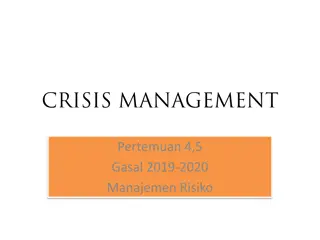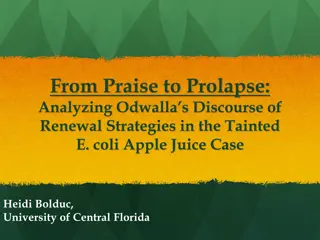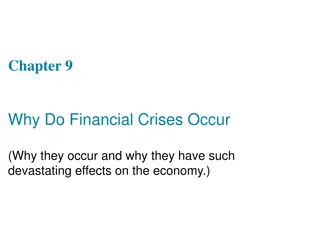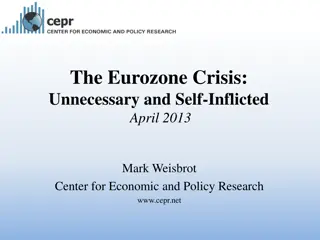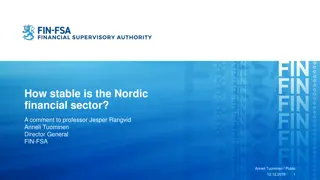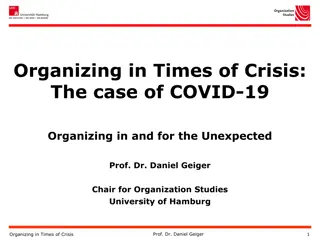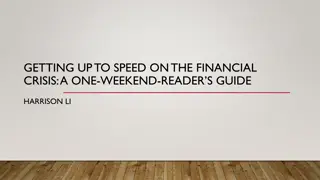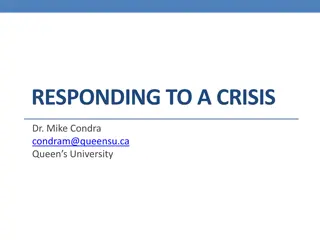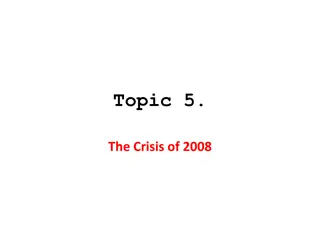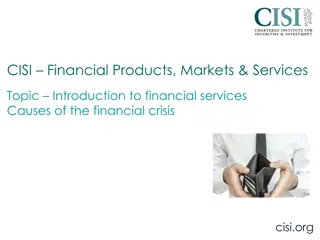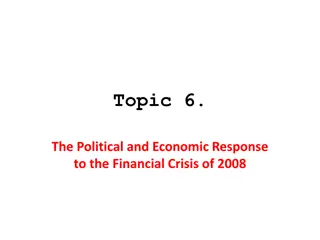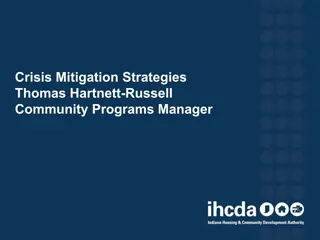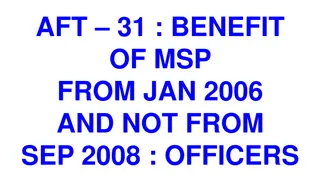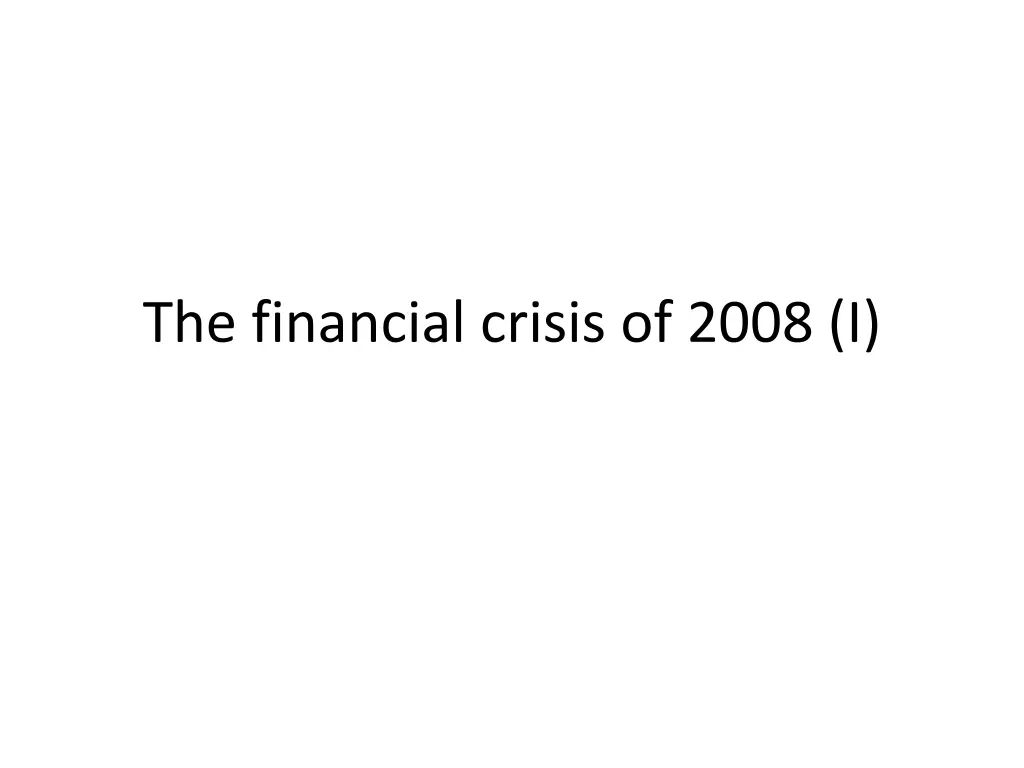
Understanding the Financial Crisis of 2008 and Its Impact on Global Economy
Explore the origins and complexities of the 2008 financial crisis, including factors such as market psychology, financial innovations, and the evolution of central banking. Discover how financial deregulation and the development of complex derivative markets played key roles in shaping this significant event and its long-term effects on the economy.
Download Presentation

Please find below an Image/Link to download the presentation.
The content on the website is provided AS IS for your information and personal use only. It may not be sold, licensed, or shared on other websites without obtaining consent from the author. If you encounter any issues during the download, it is possible that the publisher has removed the file from their server.
You are allowed to download the files provided on this website for personal or commercial use, subject to the condition that they are used lawfully. All files are the property of their respective owners.
The content on the website is provided AS IS for your information and personal use only. It may not be sold, licensed, or shared on other websites without obtaining consent from the author.
E N D
Presentation Transcript
A recap We have covered bubbles and crisis from a variety of perspectives. These included: Market psychology Financial inventions The link between financial markets and real economic activity Banking and Central Banking evolution and practice Development of economic theory One of the things we noted is that crises became more complex as the economy evolved into new financial and production directions.
Structure of weeks 10 and 11 In the last two weeks we will discuss two related questions: The latest (2008) crisis and its long effects on the global economy. The current state of the debate between economists on the following three topics: The psychology of bubbles and financial markets The evolving role and instruments of central banks The effects of the latest crisis in the real economy This week we will cover a broad history of the crisis and revisit literature on psychology. Next week we will tackle the last two topics.
The background Financial deregulation in the west started from the 1980s and intensified after the collapse of the Communist block in 1989. This was a period of substantial global financial integration to an extent that the world had not seen since the first world war. From early 2000 global economic growth was positive peaking in the years prior to the crisis. There was substantial growth both in the developed economies (US/EU esp.) and most developing countries, as well as the new market economies of the previous soviet block.
Background- the development of complex derivative markets . At the same time financial markets were becoming more internationally integrated, deregulated, and were creating new financial products. The development of complex formulas on pricing risk (see last lecture on the LTCM) created an appetite of entirely new and sophisticated ways to diversify risk. Products that traditionally were seen as risky could be organised in batches and sold to the market in novel ways that mitigated or masked their true risk. This created complex financial products with claims far removed from the nature and probable non-market value of the underlying asset.
The US housing market A home is the principal item of wealth of most US households. Mortgage payments build equity, and homebuyers can take advantage of tax deductions on interest and property-tax payments. If home prices increase in line with the rate of inflation, home ownership protects the value of wealth. Homeowners may also stand to make capital gains if they can sell their homes. Between 1997 and 2006 the average home price jumped by 79 percent, from 109 to 195, an annual average increase of 6 percent. As Figure 15.1 makes clear, the price boom was an unparalleled event in the US housing market.
Driven by fundamentals? During the boom years most policymakers, academics, and industry experts believed that the increase in average home prices was connected to the fundamentals, and did not express concern about excessive price escalations. However, this period (2000-2008) saw unsustainable and unprecedented increases in home prices and household indebtedness, extreme leveraging in unregulated shadow banking institutions, and the explosive growth of bilateral swap derivatives as instruments of speculation. Two questions: First, what factors account for the sharp increase in home prices after 1997? Second, why did the turndown in the housing market, an essentially local market and a relatively small sector of the overall economy, shake the foundations of the US and global economy so deeply that attempts to contain it by the government, the Fed, and regulators were generally unsuccessful? Answers to these questions relate to the securitization of mortgages and other types of debt, the leveraging of households and financial institutions, and the opaqueness of the financial sector due to deregulation and over-the-counter (OTC) derivatives trades.
What are subprime markets? As a point of reference, consider the pre-securitization originate-and-hold mortgage contract . Two actors: The borrower (the homebuyer) and the lender (a bank or thrift institution). When the prospective borrower applied for a loan the lender checked their credibility in terms of net wealth, income, credit score, and the loan-to-value (LTV) ratio, i.e. the ratio of the loan to the value of the house. The lender hired an appraiser to get an independent valuation of the property, as the property was the collateral for the loan. Once the mortgage contract was signed the bank extended the loan and held on to the contract, which meant that the borrower made monthly principal and interest payments (P+I) to the lender until the mortgage was fully paid. Until the 1980s, other than the government-sponsored enterprises (GSEs) that purchased conforming loans, there was no secondary market in which the lender could sell the mortgage.
The new mortgage market was a complex, multi-stage affair with many stakeholders. The following brief summary of the securitization process, seen in stages A through E show the overall complexity. (See Bilginsoy ch. 15 for details) Stage A:The borrower received the loan from an originator, which was a bank or a non-bank mortgage entity. The originator did not hold on to the loan but sold mortgages to a securitizer (or securitized the debt itself) in due course. Stage B: The securitizer, pooled the mortgages it purchased or originated and issued bonds backed by the income streams of these pools. Securitizers could be commercial or investment banks. The securitization process involved packaging mortgages, creating structured assets against the collateral of interest and principal payments of these pools, under-writing the securities, filing with the authorities, and arranging credit rating of securities. Private-label securitization was usually carried out by a bank-sponsored trust or fiduciary called a special purpose vehicle (SPV). SPVs were bankruptcy-remote entities are legally separate from sponsors other obligations. This was intended to ensure that obligations to the mortgage-backed- security (MBS) investors were separated from the bank s other obligations and to safeguard investors from misfortunes that may befall the parent.
Securitization gradually expanded to more complex and less transparent synthetic collateralized debt obligations (CDOs) that were backed by various other types of structured debt, such as pooled mortgage, credit-card, student-loan, and auto-loan securities. Soon CDOs were issued that were based on pools of CDOs. So you had many layers of collaterals. As there was no pre-existing secondary market for these CDOs were priced via new mathematical-statistical modelling (See last lecture on LTCM). The assessment of the default risk of CDOs was performed by private credit- rating agencies, such as Standard and Poor s, Moody s, and Fitch. The grades that these agencies assigned to bonds were a primary source of information for investors. Stage C: Investors purchased Mortgage Backed Securities (MBSs) and CDOs from the securitizer. These investors included private investors, GSEs, pension funds, insurance companies, and sovereign funds, as well as banks themselves. Two features of this link in the chain are worth emphasizing. First, asset managers, such as hedge funds, mutual funds, or investment banks, were located between the SPVs and most of the final investors. Second, banks created yet another layer of complexity in the system through structured investment vehicles(SIVs). Similar to SPVs, SIVs were sponsored by banks, but they were legally independent and, therefore, off the balance sheets of the sponsors.
The primary task of SIVs was to borrow from the money markets by selling short- term commercial paper to invest in MBSs and CDOs that had longer-term maturities. SIVs served several purposes. First, they added to the profits of the sponsor bank from the spread between the long- and short-term interest rates. Second, they served as repositories for the securitizer banks unsold MBSs and CDOs. SIVs often turned into storehouses for the unsold lowest-grade debt, later called toxic waste. Third, SIVs offered banks a means to circumvent capital requirements. Once the loans were removed from the balance sheet and capital was freed up banks could extend more credit. Stage D: Because the original lender was now out of the picture the home-buyer made monthly interest and principal payments to a servicer, which also was in charge of holding escrow accounts for taxes and insurance and managing delinquent loans and foreclosures. After deducting its fees the servicer transferred these payments to the SPV. The SPV made the periodic payments to the investors of the MBSs and CDOs from these funds. Stage E: Some MBS and CDO investors hedged their portfolios by purchasing Collateralised Default Swaps (CDS) from the financial insurer.
The whole system dependent eventually on two things: 1. The increasing price of the underlying assets. 2. The solvency of the counterparties- something later termed systemic risk.
How diversified was risk? While the large number of actors that offer specialized services gives the impression that multi-stage securitization process was a very crowded field, in fact, perhaps two dozen institutions, either directly or via their subsidiaries, dominated the chain, and many performed several tasks simultaneously. The same prominent financial institutions were, at the same time, the primary securitizers, originators, servicers, underwriters, short-term creditors, and investors. At the end of 2007, 20% of the outstanding mortgage-related securities were held by foreign investors, followed by Fannie Mae and Freddie Mac (16 %), US commercial banks (15 %), and mutual funds (11 %). The total share of the next set of large investors, i.e. insurance companies, pension funds, S&Ls, and state and local governments, was 23 %. The viability of the mortgage-securitization chain relied critically on homebuyers continuing to make payments on mortgages. The ultimate source of income for everyone in the chain was the monthly payments of the homebuyers, and for the system to function it was imperative to avoid widespread defaults and foreclosures. There were two immediate flaws in the mortgage-securitization chain: First, it was afflicted with perverse incentives at every stage that aggravated the risk in the system. The profits of the originators and securitizers depended on the volume of mortgages and securities issued. Both were also able to pass the risk to the next agent in the chain. When prices started to collapse it become evident that the counterparts where parts of the same financial network and institutions. The complex legal framework was a foil that underplayed the true nature of systemic risk. The second problem was that the process was reliant on short-term borrowing. Generalized deterioration of asset values and declining net worth could then easily lead to insolvencies throughout the chain.
Michael Burry- The anti-swindler He was the founder of the hedge fund Scion Capital, which he ran from 2000 until 2008. In 2005, Burry started to focus on the subprime market. Burry's research on the values of residential real estate convinced him that subprime mortgages, and the bonds based on these mortgages, would begin losing value when the original repayment rates were replaced by much higher rates, often in as little as two years after initiation. This conclusion led Burry to short the market by persuading Goldman Sachs to sell him credit default swaps against subprime deals. Burry looks at fundamentals and likes to invest where there is a high margin of safety. "I don't go out looking for good shorts. I'm spending my time looking for good longs. I shorted mortgages because I had to. Every bit of logic I had led me to this trade and I had to do it. Allegedly Warren Buffet has a similar investment strategy. Scion Capital ultimately recorded returns of 489.34% between its November 1, 2000 inception and June 2008. The S&P 500 returned just under 3% including dividends over the same period. When a market is run by swindlers, what does a long investor do? He goes short! Only problem: The market can remain irrational longer than you can remain solvent Bury suffered an investor revolt, where some investors worried the logic was wrong and demanded to withdraw their investment in Scion Capital's hedge fund, before his predictions came true.
UK market- collapse of Norther Rock 12 September 2007, Northern Rock asked the Bank of England, as lender of last resort, for a liquidity support facility due to problems in raising funds in the money market to replace maturing money market borrowings. 14 September 2007, the first day branches opened following the news, there was a run on the bank. This bank run was not the traditional form, where depositors withdraw money in a snowball effect, leading to a liquidity crisis; instead, it occurred in the aftermath of the liquidity crisis. It was estimated that 1 billion was withdrawn by customers that day, about 5% of the total bank deposits held by Northern Rock. 17 September worried savers continued to flock to withdraw their savings, it was reported that an estimated 2 billion had been withdrawn since the bank applied to the Bank of England for emergency funds. Later that day, the Chancellor of the Exchequer, Alistair Darling, announced that the British Government and the Bank of England would guarantee all deposits held at Northern Rock. By January 2008, Northern Rock's loan from the Bank of England had grown to 26bn, by February the bank was effectively taken into state ownership. 2008 Bailouts: October 13, 2008 HM Treasury injected new capital into Royal Bank of Scotland Group plc, Lloyds TSB and HBOS plc, to avert financial sector meltdown. It made some gains by selling the stake in Lloyds and HBOS in 2013, but losses are expected to be recorded for the Royal Bank of Scotland as well as Northern Rock
September 2008: Collapse of Lehman Brothers 2008, September 7 Fannie Mae and Freddie Mac were taken over by the federal government. September 15: Lehman Brothers went bankrupt after the Federal Reserve declined to guarantee its loans, causing the Dow Jones to drop 504 points, its worst decline in seven years. The same day, Bank of America purchased Merrill Lynch. 9/16 The Federal Reserve took over American International Group. 9/21 Goldman Sachs and Morgan Stanley converted themselves from investment banks to bank holding companies to be able to use the Federal Reserve lender of last resort facilities. 9/26 Washington Mutual went bankrupt after a bank run. 9/29 The House of Representatives rejected the Emergency Economic Stabilization Act of 2008. In response the Dow Jones dropped 770 points, its largest single-day decline. 10/3 Congress passed the Emergency Economic Stabilization Act of 2008. 12/16 The federal funds rate was lowered to zero percent. 2009, January The Big Three automobile manufacturers received a bailout. 2/13 Congress approved the American Recovery and Reinvestment Act of 2009, a $787 billion economic stimulus package. 3/6 The Dow Jones hit its lowest level of 6,443.27. In 2008-10 over 65 U.S. banks have become insolvent and have been taken over by the FDIC. Combined, these banks held over $55 billion in deposits, and the takeovers cost the federal government an estimated $17 billion
TED spread is the difference between the interest rates on interbank loans (LIBOR) and on short-term U.S. government debt ("T-bills"). LIBOR= London Inter-bank Offered Rate is an interest-rate average calculated from estimates submitted by the leading banks in London. Each bank estimates what it would be charged were it to borrow from other bank TED spread = 3-month LIBOR rate - 3-month T-bill interest rate The size of the spread is usually denominated in basis points (bps). For example, if the T-bill rate is 5.10% and ED trades at 5.50%, the TED spread is 40 bps.
The policy response- Quantitative Easing In exceptional circumstances, when interest rates are at their effective lower bound, money creation and spending in the economy may still be too low to be consistent with the central bank s monetary policy objectives. One response is to undertake a series of direct asset purchases, or quantitative easing (QE). QE is intended to boost the amount of money in the economy directly by purchasing assets, mainly from non-bank financial companies. QE initially increases the amount of bank deposits those companies hold (in place of the assets they sell). Those companies will then wish to rebalance their portfolios of assets by buying higher-yielding assets, raising the price of those assets and stimulating spending in the economy. As a by-product of QE, new central bank reserves are created.
Once short-term interest rates reach the effective lower bound, it is not possible for the central bank to provide further stimulus to the economy through the discount (interest rate) window. QE involves a shift in the focus of monetary policy to the quantity of money in the economy. The central bank purchases a quantity of assets, financed by the creation of broad money and a corresponding increase in the amount of central bank reserves. The sellers of the assets will be left holding the newly created deposits in place of government bonds or other assets. This will raise the value of those assets and lower the cost to companies of raising funds in these markets. That, in turn, should lead to higher spending in the economy. The effect these direct purchases (especially of more risky assets than government bonds) have on the economy is many fold: It immediately exchanges assets for cash, giving liquidity to the commercial banks. This also directly improves their solvency if cash is exchanged for more risky assets (loans to private sector). It stabilises the value of assets in the market (due to Central Bank demand) allowing a better valuation of assets held by the commercial banks that had seen their prices collapse. The outcome is commercial bank balance sheets remain (or are again) solvent. It reduces the rate of interest of government bonds (as direct purchases increase their price). This means commercial banks will have less incentive to hold government bonds that give close to zero interest rate return.
Consider the purchase of 1 billion of government bonds from a pension fund (figure 3). As the pension fund does not hold a reserves account with the Bank of England, the commercial bank with whom they hold a bank account is used as an intermediary. The pension fund s bank credits the pension fund s account with 1 billion of deposits in exchange for the government bonds. This is shown in the first panel of Figure 3. The Bank of England finances its purchase by crediting reserves to the pension fund s commercial bank (second row). The commercial bank s balance sheet expands: new deposit liabilities are matched with an asset in the form of new reserves (third row).
The Great Recession The Great Recession was a period of general economic decline observed in world markets during the late 2000s and early 2010s. Year Unemployment Rate (US) GDP Growth 2.9% 1.9% -0.1% Inflation 4.4% 5.0% 7.3% 2.5% 4.1% 0.1% 2006 2007 2008 The scale and timing of the recession varied from country to country. The International Monetary Fund concluded that the overall impact was the most severe since the Great Depression in the 1930s. 9.9% -2.5% 2.7% 2009 9.3% 8.5% 2.6% 1.6% 1.5% 3.0% 2010 2011 The Great Recession stemmed from the collapse of the United States real-estate market, in relation to the financial crisis of 2007 to 2008. 7.9% 2.2% 1.7% 2012 6.7% 1.8% 1.5% 2013 The recession was not felt equally around the world. Most of the world's developed economies fell into a recession, but some developing economies did not see substantial growth decreases. China and India s economies grew substantially during this period. 5.6% 5.0% 4.7% 4.1% 3.9% 2.5% 2.9% 1.6% 2.2% 2.9% 0.8% 0.7% 2.1% 2.1% 1.9% 2014 2015 2016 2017 2018 Youth unemployment in 33 countries that are part of Organization for Economic Cooperation and Development (OECD) has risen by 18.8 % from 2007 to 2009, according to OECD calculations.
European debt crisis The unravelling of public debt spreads in the EU. After 2008 the interest rate member states paid for their public debt varied between countries.
Theoretical perspectives Efficient Market Hypothesis (EMH). The basic argument was extremely influential up to 2008 as the reason why markets should be unregulated and would tend toward correct valuations of assets. Today we will consider the following extensions. Modern behavioural economics from a mainstream perspective (continuing on what Ragu covered last week). The social element of psychological behaviour that sees herding behaviour as basic to understanding market interaction. The performativity thesis, in which markets and their functions are created by economists, financiers and policy practitioners and are not naturally occurring social institutions.
Modern Behavioural Economics Last week we noted that Investors are subject to waves of optimism and pessimism and this causes prices to deviate systematically from their fundamental values and later to exhibit mean reversion Behaviour may reflect an interaction of cognitive and emotional factors. This week we will see how such a mechanism work, through the work by Nicola Gennaioli, Andrei Shleifer and Robert Vishny. They model a financial markets in which investor beliefs are shaped by representativeness. In Neglected Risks: The Psychology of Financial Crises (2015) their model generates debt over-issuance, "this time is different" beliefs, neglect of small risks, under- and over-reaction to information, boom-bust cycles, and excess volatility of prices.
Neglected Risks: The Psychology of Financial Crises (2015) Economists typically model financial crises as responses to shocks to which investors attach a low probability ex ante, but which nonetheless materialize. Such shocks are consistent with rational expectations in that investors recognize that there is a small chance that the shock might occur, but they are harder to reconcile with the observation that crises are not that unusual. The 2008 financial crisis in the United States has deepened the challenge, by bringing up direct evidence that investors underestimated the risk of a crisis. This paper presents a psychological theory of the neglect of risk and financial crises. The paper seeks to explain precisely why the probability estimates of a crisis in a boom are too low at first and then seen as too high. The model yields boom-bust financial crises based entirely on beliefs; the model does not incorporate any economic mechanisms that amplify the shocks, such as fire sales or imperfect capital markets.
The model is based on Kahneman and Tversky's (1972) idea of representativeness. Representativeness induces people to overestimate the probability of outcomes that are relatively more likely in light of recently observed data. Representativeness is related to the idea of similarity: after seeing some data, people concentrate their forecasts on outcomes similar to the data observed, neglecting alternative future paths. When people rely on representativeness to make judgments, they are likely to judge wrongly because the fact that something is more representative does not actually make it more likely. An investor observing a string of good news (Internet stocks, housing prices) views them as being generated by a favourable economic scenario. The investor then puts too much probability weight on that scenario and neglects the risk of bad outcomes. Observing some bad news intermixed with good news does not change the investor's mind. He views the bad news as an unrepresentative and under-reacts. It takes a string of unfavorable news to render the bad outcome sufficiently more likely that the representative scenario changes from boom to bust. Previously ignored bad news are remembered, leading to a sharp rise in the perceived probability of a crisis and a collapse of prices. The investor now overreacts to the bad news, especially if the true probability of the low state remains low. This mechanism yields purely belief-driven boom-bust cycles.
Some outcomes of this research 1. These models explain how moderate probability events are first neglected, but then exaggerated when news pattern becomes consistent with them. It thus accounts for "this time is different" phenomenon without recourse to low probability shocks. These models explains how boom and bust cycles in debt valuation and issuance can arise purely through volatility in expectations, even with-out the standard economic mechanisms of amplification. 2. In another paper they focus on investor optimism in the securitized loan market. As banks make and securitize loans to cater to investor demand, the incentives of even fully rational banks lead to overexpansion of lending and excessive leverage in good times, but then fire sales and credit crunches in bad times. Another mechanism is that during the period of growing home prices and securitization, market participants neglected the risk that home prices could collapse. This neglect of small risks could have led to the massive assumption of such risks by risk-averse investors, who then fled to safety when they became aware of the risks they were bearing.
Herding, followers and leaders Baddeley (2010, 2018) focuses on the importance of herding and puts more emphasis on how the social environment influences individual psychology and decision. However, note that the focus is still broadly on individual behaviour and different traits that different individuals have, and how they can be manipulated. This research notes that socio-cultural norms, attitudes, habits, membership of groups will influence decisions. Discussion of beliefs with friends and associates will mean that information selected is determined by the groups to which the listener belongs. For imitative behaviour in a wider socio-economic context, social norms will regulate and sustain certain emotions, e.g. in encouraging conformity to particular social and economic norms.
Herding Evidence of herding in other animals, suggests that herding may have (had) an evolutionary value in a social context; it is not just about individuals maximizing their own outcomes. Herding may have evolutionary advantages for humans not just because of informational influences as highlighted in the theories above. Conformist individuals are more susceptible to intragroup social pressure, suggesting a normative influence. Normative influences, such as receptivity to social influence, may be particularly important in understanding herding. Docile members have the intelligence and motivation to learn quickly from social information and do not screen social information for its contribution to personal fitness. Docility allows people to believe large numbers of propositions without any direct proof. Docile individuals are also more adept at social learning, making them more able to acquire knowledge, skills and proper behaviours i.e. the values, goals and attitudes that are useful in overcoming environmental obstacles.
Copycats and . Herding and imitation in economic and financial decision-making may reflect a social learning process but this will be moderated by emotions and by socio- psychological traits determining receptivity to social influence. Our tendency to imitate, follow others and group together can be reasonable strategies to improve our lives and evolutionary life chances. But there are three common threads that unify conceptions of herding that we can observe in ourselves and other copycats around us. First, and most obviously, herding involves imitation. Second, it is a group phenomenon: someone imitating just one other person is not herding; many people imitating one person and many people imitating many people is herding. Third, herding may sometimes be driven by unconscious motivations but it is not random. Conscious and unconscious forces encourage us to follow in systematic ways. Herding definition: A systematic choice to copy others in a group. Humans are not conformists always and everywhere. There are plenty of rebels and contrarians.
.Contrarians Understanding herding copycats will also help us to understand the essence of their opposites: the contrarians. Contrarians are anti- herders , where anti- herding can be defined as a choice not to copy others in a group. Anti- herding is not as dissimilar from herding as we might at first imagine. Anti-herding is not random; but it is the mirror image of imitation because an anti-herding contrarian acts against, not in concert with, the group. Anti- herding shares two of the three features of herding outlined above, but with a few twists. Contrarians are not hermits. They worry what others think, but they may deliberately decide to oppose the herd sometimes by leading the group instead of following it. Like herding, anti- herding is systematic, not random, and perhaps it is more systematic if it is driven by deliberate, conscious choices
Social influences of herding Social influences underlying our propensities to herd can be roughly divided into the categories of informational influences and normative influences. Informational influences include all the ways in which we learn by gathering information from others around us. What others do, and whether they succeed, is important information we can use to our own advantage. We observe how others choose and decide and this helps us to choose and decide for ourselves. Normative influences encompass the norms and customs that define the groups and communities around us. Our responses to normative influences are often less conscious and deliberate than our responses to informational influences. We copy others because we feel a compulsion from others around us to conform reflecting social norms, peer pressure and group think.
Herding and economic outcomes Neither rebellion nor conformity is inherently good or bad. If we follow others in buying into a rising housing market, for example, we may do very well out of gains in our property s value. If we lead others out of a burning building, then we may all survive. If contrarians lead others into war, terrorism or gang violence, then they are risking others lives, and sometimes their own. Copycats and contrarians are driven by the tensions between exploiting and using the group versus belonging and contributing to the group.
Behavioural policy conclusions Using our conformist inclinations as a policy tool for social nudging has become very popular. Small changes in the way information and options are presented encourage people to change their choices in a direction the public policymaker wants. Nudges are now used extensively by behavioural public policymakers, such as the UK s Behavioural Insights Team . Using anti- herding as a policy tool is, however, a conceptual and logistical challenge. We need to devise incentives for contrarianism. Some argues that there should be additional incentives for risk-taking in e.g. scientific research. If we can develop a better understanding of the complex social interactions driving copycats and contrarians, then we will be better able to identify solutions to moderate herding and anti- herding when they are problematic, as well as to encourage herding and anti- herding when they are beneficial.
Mackenzie and performativity MacKenzie, Donald (2006). An Engine, Not a Camera: How Financial Models Shape Markets. Mackenzie s story is that the emergence of modern economic theories of financial markets transformed the practice of finance. History of financial economics: Finance as a subject of study was treated descriptively until the 1960s . There was little sophisticated mathematical theory of financial markets. A distinctive academic field of financial economics begun to emerge in the 1950s, gathering pace in the 1960s/70s. Its core was a complex mathematical model of markets. The central question is the relationship between two events: That of changing financial markets and that of the emergence of modern finance theory. The new markets provided financial economists with their subject matter, with data against which to test their models, and with some of at least the more elementary concepts they employed. Financial economics did more than analyze markets; it altered them. It was an engine : an active force transforming its environment, not a camera passively recording and uncovering existing structures.
Thus,, successful futures trading requires more than the existence of economic actors who may benefit from it. For futures trading to be possible, the underlying asset has to be standardized. The standardization of grain and other primary commodities starting in the 19nth century was both a technical and a social process. This means that the infrastructures of markets are diverse, and changing through time. Not all markets are the same- markets are engineered to perform specific tasks. Economics itself is a part of the infrastructure of modern markets: . . . economics, in the broad sense of the term, performs, shapes and formats the economy, rather than observing how it functions (Callon, 1998, p. 2). The academic discipline of economics does not always stand outside the economy, analyzing it as an external thing; sometimes it is an intrinsic part of economic processes. Social processes, especially in new fields/domains, are to a large degree driven by validation from some part of society that has the authority to do so. Academic economics by theorising about an ideal interaction create the social validation of actual markets and the framework for this market will take. Barnesian performativity, after the sociologist Barry Barnes, who noted the central role in social life of self-validating feedback loops.
Performativity- some conclusions This literature emphasizes the embedding of markets in cultures, in politics and ideology, and in the technological infrastructure that is engineered. Markets are not natural socially pre-existing entities, but the outcome of institutional design and social evolution. Therefore, the story is much more complicated than simply thinking of producing the right incentives to avoid financial bubbles and crisis. Because for every competent incentives framework a way around it can normally be found by speculators gaming the system. Models and theories create their own realities and transform/create the agents who perform in them. Market behaviour has to do with the broader orientation of society, its values and socially accepted behaviour and, the nature that markets and financial innovation is expected to take, and the needs they ought to and habitually fulfil. Thinking in the form of incentives or nudges reduces the broader problem into immediate cognitive stimuli, losing the broader social element of the problem and its deep-seated nature.

